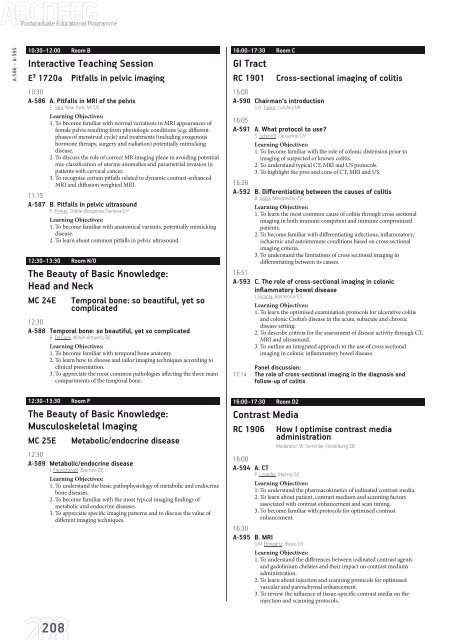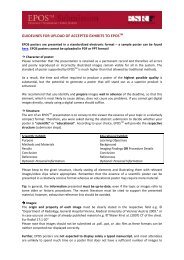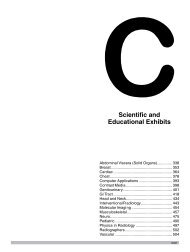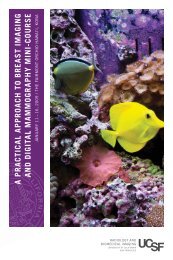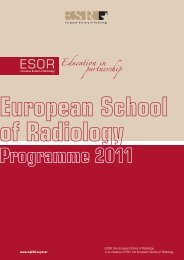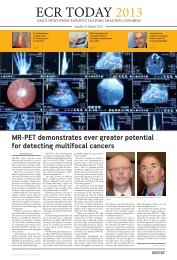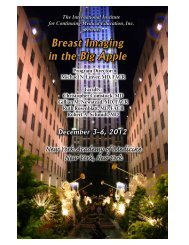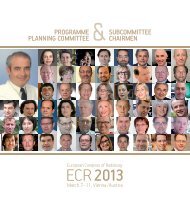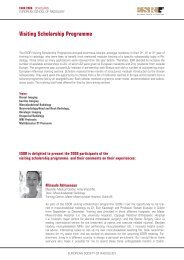ECR 2013 â Final Programme - myESR.org
ECR 2013 â Final Programme - myESR.org
ECR 2013 â Final Programme - myESR.org
- No tags were found...
Create successful ePaper yourself
Turn your PDF publications into a flip-book with our unique Google optimized e-Paper software.
Postgraduate Educational <strong>Programme</strong>A-586 – A-59510:30–12:00 Room BInteractive Teaching SessionE³ 1720a Pitfalls in pelvic imaging10:30A-586 A. Pitfalls in MRI of the pelvisE. Sala; New York, NY/USLearning Objectives:1. To become familiar with normal variations in MRI appearances offemale pelvis resulting from physiologic conditions (e.g. differentphases of menstrual cycle) and treatments (including exogenoushormone therapy, surgery and radiation) potentially mimickingdisease.2. To discuss the role of correct MR imaging plane in avoiding potentialmis-classification of uterine anomalies and parametrial invasion inpatients with cervical cancer.3. To recognise certain pitfalls related to dynamic contrast-enhancedMRI and diffusion weighted MRI.11:15A-587 B. Pitfalls in pelvic ultrasoundK. Kinkel; Chêne-Bougeries/Geneva/CHLearning Objectives:1. To become familiar with anatomical variants, potentially mimickingdisease.2. To learn about common pitfalls in pelvic ultrasound.12:30–13:30 Room N/OThe Beauty of Basic Knowledge:Head and NeckMC 24E Temporal bone: so beautiful, yet socomplicated12:30A-588 Temporal bone: so beautiful, yet so complicatedB. De Foer; Wilrijk-Antwerp/BELearning Objectives:1. To become familiar with temporal bone anatomy.2. To learn how to choose and tailor imaging techniques according toclinical presentation.3. To appreciate the most common pathologies affecting the three maincompartments of the temporal bone.16:00–17:30 Room CGI TractRC 1901Cross-sectional imaging of colitis16:00A-590 Chairman‘s introductionS.A. Taylor; London/UK16:05A-591 A. What protocol to use?S. Schmidt; Lausanne/CHLearning Objectives:1. To become familiar with the role of colonic distension prior toimaging of suspected or known colitis.2. To understand typical CT, MRI and US protocols.3. To highlight the pros and cons of CT, MRI and US.16:28A-592 B. Differentiating between the causes of colitisB. Gallix; Montpellier/FRLearning Objectives:1. To learn the most common cause of colitis through cross sectionalimaging in both immune competent and immune compromisedpatients.2. To become familiar with differentiating infectious, inflammatory,ischaemic and autoimmune conditions based on cross sectionalimaging criteria.3. To understand the limitations of cross sectional imaging indifferentiating between its causes.16:51A-593 C. The role of cross-sectional imaging in colonicinflammatory bowel diseaseJ. Rimola; Barcelona/ESLearning Objectives:1. To learn the optimised examination protocols for ulcerative colitisand colonic Crohn‘s disease in the acute, subacute and chronicdisease setting.2. To describe criteria for the assessment of disease activity through CT,MRI and ultrasound.3. To outline an integrated approach to the use of cross sectionalimaging in colonic inflammatory bowel disease.Panel discussion:17:14 The role of cross-sectional imaging in the diagnosis andfollow-up of colitis12:30–13:30 Room PThe Beauty of Basic Knowledge:Musculoskeletal ImagingMC 25E Metabolic/endocrine disease12:30A-589 Metabolic/endocrine diseaseJ. Freyschmidt; Bremen/DELearning Objectives:1. To understand the basic pathophysiology of metabolic and endocrinebone diseases.2. To become familiar with the most typical imaging findings ofmetabolic and endocrine diseases.3. To appreciate specific imaging patterns and to discuss the value ofdifferent imaging techniques.20816:00–17:30 Room D2Contrast MediaRC 1906 How I optimise contrast mediaadministrationModerator: W. Semmler; Heidelberg/DE16:00A-594 A. CTP. Leander; Malmö/SELearning Objectives:1. To understand the pharmacokinetics of iodinated contrast media.2. To learn about patient, contrast medium and scanning factorsassociated with contrast enhancement and scan timing.3. To become familiar with protocols for optimised contrastenhancement.16:30A-595 B. MRIG.M. Bongartz; Basle/CHLearning Objectives:1. To understand the differences between iodinated contrast agentsand gadolinium chelates and their impact on contrast mediumadministration.2. To learn about injection and scanning protocols for optimisedvascular and parenchymal enhancement.3. To review the influence of tissue-specific contrast media on theinjection and scanning protocols.


